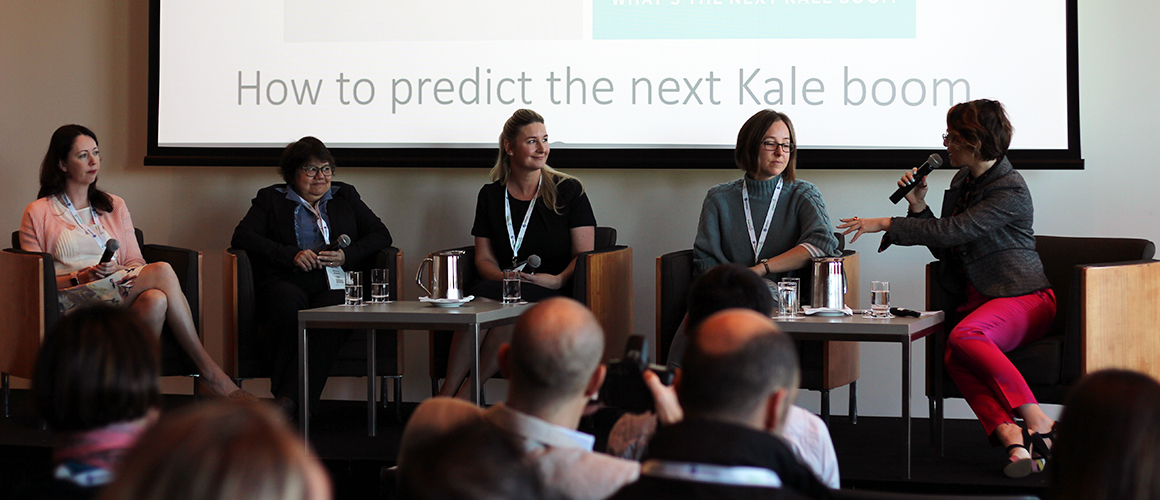Hort Connections food trends panel shines a light on the future of vegetable products
In a week that saw delegates take the plunge and try the now-infamous broccoli latte, an expert panel at Hort Connections 2018 has looked into the crystal ball to consider what other foods could shape the future of our industry.
Moderated by educator and entertainer Alice Zaslavsky, Hort Innovation’s panel Future food trends: What’s the next kale boom brought together four leading vegetable researchers and academics:
- Chanel Day (Nielsen Australia)
- Dr Denise Hamblin (Colmar Brunton)
- Heather Smyth (QAAFI)
- Dr Mary Ann Augustin (CSIRO)
In the discussion, Denise’s extensive experience in the vegetable sector came to the fore – particularly her levy-funded work with Colmar Brunton on the Project Harvest consumer tracking study and, more recently, a study investigating the potential of Australian native vegetables and Asian vegetable varieties.
Delegates heard that there are two major trends currently shaping Australian food consumption: the desire for provenance and authenticity in food stories, and an increasing understanding of food as medicine. With Australian vegetables – and especially native varieties – in a great position to capitalise on both of these trends, Denise said that education is key to helping consumers understand the benefits on offer.
The panel also delivered data-driven insights, thanks to Chanel’s expertise from Nielsen Australia’s data projects, including the ongoing levy-funded Harvest to Home online dashboard. Chanel shared three of the latest lessons from the project:
- Consumers are busier than they’ve ever been before, and they’re looking for healthy options that are convenient to them, leading to huge growth in prepared categories like pre-cut carrots and salad mixes.
- Shifts in Australian population demographics are impacting vegetable consumption, with recent overall increases in immigration from Asian nations leading to greater consumption of leafy Asian vegetable varieties.
- The health and wellness wave presents a great opportunity for Australian vegetables to align themselves with health messaging.
These insights bolstered comments from the other panellists about their own projects creating new products, like Heather’s levy-funded work with QAAFI developing ‘fortified fresh produce’: new varieties of vegetables with increased levels of key nutritional compounds.
By creating visually distinct vegetable varieties, like purple sweetcorn, the project has been able to create a point of difference for consumers and reinforce the distinct health offerings these products have to offer.
Finally, of course, the broccoli latte and all things powdered veg were on the table as Mary Ann discussed her levy-funded project using technology to create new value-added products from food waste.
The project has been designed to create alternative avenues to market for produce that may not have made it to the retail market, whether that’s due to not meeting specifications or not receiving a viable price. While broccoli lattes may not take the world by storm, the principle behind them – adding powdered produce to everyday foods to fortify their nutrition – offers huge potential for the near future.
Importantly, Mary Ann noted that the project team is now exploring a processing hub concept to create sustainable jobs in communities and support farmers in creating value-adding products.
The panel also fielded questions from the audience, with insightful discussions taking place about the next steps for the industry – including panellists being put on the spot with the simple question: “What is the next kale?”
The responses were interesting insights into potential avenues for our industry, with perhaps the most unorthodox option coming from Heather’s suggestion that beauty products offer a great potential avenue for vegetables’ health credentials to find a new home.
If you weren’t able to make it to the panel, don’t worry – Hort Innovation continues to deliver levy-funded projects that are helping our industry understand the consumer trends shaping the future of food in Australia. We’ll always keep you updated on new research and development through the Weekly Update, but you can access all the latest resources coming out of these projects on the Hort Innovation website!
This post appeared in the AUSVEG Weekly Update published 21 June 2018. Subscribe to the Update using our online form to receive the latest industry news in your inbox every week!


